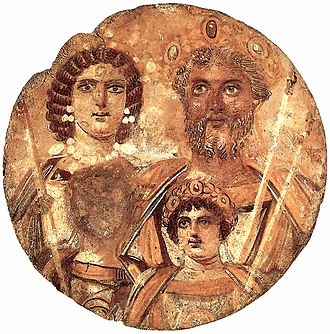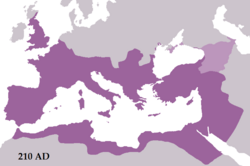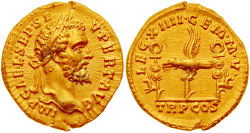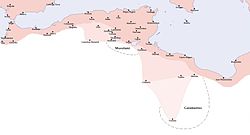Septimius Severus
Septimius Severus (Lucius Septimius Severus, 11 April 145 AD – 4 February 211) was Roman Emperor from 193 AD to 211. Severus was born in Leptis Magna in the province of Africa. Severus was born an African, and some portraits show him as such. In 187 he married Julia Domna, from Syria.
| Septimius Severus | |||||
|---|---|---|---|---|---|
| Emperor of the Roman Empire | |||||
 Alabaster bust of Septimius Severus | |||||
| 14 April 193 – 4 February 211 (17 years, 296 days) | |||||
| Predecessor | Didius Julianus | ||||
| Successor | Caracalla and Geta | ||||
| Born | April 11, 145 Leptis Magna (Libya) | ||||
| Died | February 4, 211 (aged 65) Eboracum (York) | ||||
| Wives |
| ||||
| Issue | Caracalla and Geta | ||||
| |||||
| Dynasty | Severan | ||||
| Father | Publius Septimius Geta | ||||
| Mother | Fulvia Pia | ||||
As a young man, Severus advanced under the reigns of Marcus Aurelius and Commodus. Severus seized power after the death of Emperor Pertinax in 193 during the so-called Year of the Five Emperors. After deposing the incumbent emperor Didius Julianus in a bloodless coup, Severus fought his rival claimants, the generals Pescennius Niger and Clodius Albinus. Niger was defeated in 194 at the Battle of Issus, and Albinus three years later at the Battle of Lugdunum.
After solidifying his rule, Severus waged a brief war against the Parthian Empire, sacking their capital Ctesiphon in 197. In 202 he campaigned in Africa against the Garamantes, briefly taking their capital Garama and expanding the southern frontier of the empire radically.
Late in his reign he fought the Picts in Caledonia and strengthened Hadrian's Wall in Britain. Severus died in 211 at Eboracum, succeeded by his sons Caracalla and Geta. With the succession of his sons, Severus founded the Severan dynasty, the last dynasty of the empire before the Crisis of the Third Century.
Assessment
By the close of his reign the Roman Empire reached an extent of over 5 million square kilometres, which some scholars state expanded the empire to its greatest physical extent.[1][2]
According to Gibbon, "his daring ambition was never diverted from its steady course by the allurements of pleasure, the apprehension of danger, or the feelings of humanity".[3]
He secured Africa, the agricultural base of the Empire where he was born.[4] His victory over the Parthian Empire was for a time decisive.[5] His policy of an expanded and better-rewarded army was criticised by his contemporaries Cassius Dio and Herodianus.[6][7] The large increase in military expenditure caused problems for all of his successors.[2]
Septimius Severus Media
Dynastic aureus of Septimius Severus, minted in 202. The reverse feature the portraits of Geta (right), Julia Domna (centre) and Caracalla (left). Inscription: SEVER[US] P[IUS] AVG[USTUS] P[ONTIFEX] M[AXIMUS], TR[IBUNUS] P[LEBIS] X, CO[N]S[UL] III / FELICITAS SAECVLI.
The Severan Tondo, c. 199, Severus, Julia Domna, Caracalla and Geta, whose face is erased (Antikensammlung Berlin)
Roman marble bust of Septimius Severus, early 3rd century AD, Altes Museum
Golden Bust of Septimius Severus found in 1965 at Didymoteicho in Northern Greece, now at the Archaeological Museum of Komotini.
Aureus minted in 193 by Septimius Severus to celebrate XIIII Gemina Martia Victrix, the legion that proclaimed him emperor. Inscription: IMP. CAE. L. SEP. SEV. PERT[INAX] AVG. / LEG. XIIII CEM. M. V. – TR. P., CO[N]S.
Bronze head of Septimius Severus, from Asia Minor, c. 195–211 AD, Ny Carlsberg Glyptotek, Copenhagen. Inscription: IMP. CAE. L. SEP. SEV. PERT. AVG. / LEG. XIIII, CEM M V – TRP COS.
Kushan ring with portraits of Septimius Severus and Julia Domna, a testimony to Indo-Roman relations of the period
References
- ↑ Kennedy, David L. & Derrick Riley 2012. Rome's Desert Frontiers, page 13, Routledge
- ↑ 2.0 2.1 van der Spek R.J. & De Blois, Lukas 2008. An Introduction to the Ancient World, page 272, Routledge
- ↑ Gibbon, Edward (1776). The Decline and Fall of the Roman Empire. London: Cadell. p. 96. OCLC 840075577.
- ↑ Kenneth D. Matthews, Jr., Cities in the Sand. The Roman Background of Tripolitania, 1957
- ↑ Erdkamp, Paul (2011). A Companion to the Roman Army. Malden (Massachusetts): Blackwell. p. 251. ISBN 9781444339215.
{{cite book}}: CS1 maint: date and year (link) - ↑ Cassius Dio, Roman History LXXV.2.3
- ↑ Herodianus, History of the Roman Empire III.9.2–3











